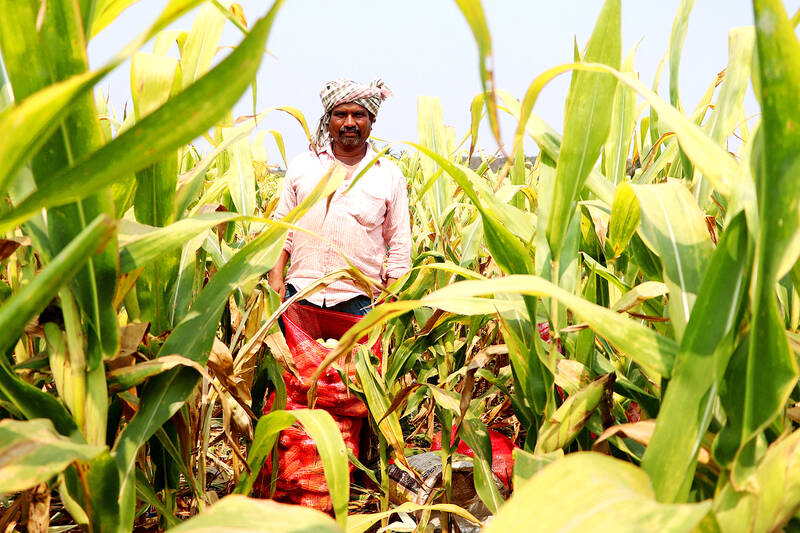Data form Earth-observation satellites are enabling farmers like Lokeswara Reddy to significantly increase their net profit, despite shifting climate patterns, high input costs and a scarcity of labor
-
By Nivedita Bhattacharjee
/ Reuters, BENGALURU, India
Lokeswara Reddy, an Indian farmer with two decades of experience, has seen his crops flourish after lean years, thanks to Earth-observation satellites.
Shifting climate patterns, high input costs, a scarcity of labor and erratic weather began to disrupt his earnings about 10 years ago, said Reddy, 52, who is now a contract farmer with agritech giant Syngenta.
Satellite data, gathered and crunched by Indian start-up Cropin and provided to him by Syngenta, now gives him optimal sowing times, weather warnings, and data on better use of irrigation and pesticides, he said.

Photo: Reuters
Over the past decade he has increased his net profit to 8,094 rupees (US$97) per hectare on corn at his farm in the southern Indian state of Andhra Pradesh, up from 2,023 rupees to 4,047 rupees, Reddy said.
“We are on a surer footing when it comes to agricultural practices; [using satellite data] safeguards us from climate change, pest and disease, problems with irrigation scheduling,” he said.
The Indian government, which just relaxed foreign investment rules for the space sector, is leaning heavily into the use of satellite data to solve problems on the ground, with agriculture a key focus.
Reuters spoke to 11 experts and farmers, six start-ups in the industry and three non-governmental organizations that said space technology and big data were primed to help Indian agriculture reach new heights.
“India’s path to leadership in the new space race lies in utilizing the power of data, and applications within the agricultural sector offer immense potential,” said Pawan Goenka, chairman of the Indian National Space Promotion and Authorization Centre, the country’s space regulatory body.
Market Research Future, an India-based data analysis firm, has said the global space agriculture market would be worth US$11.51 billion by 2032, up from US$4.99 billion last year.
Although China holds the largest market share, the sector is growing faster in India than anywhere else in the Asia-Pacific region, it said.
Cropin, founded in 2010 and backed by Google and the Gates Foundation, recently signed a deal with Amazon Web Services to crunch satellite data to solve for global food insecurity.
Cropin’s partnership with farmers, the World Bank and the government of India in 244 villages digitized more than 30,000 farm plots, covering 77 crop varieties across climate zones, a company project analysis showed in 2019.
Ninety-two percent of the farmers involved increased their average yield by 30 percent and their farm revenue by nearly 37 percent, The study showed.
The company got similar results in Africa.
Cropin and others are tapping into a burgeoning sector. The use of satellite data for crop insurance and horticulture has a market potential of about US$1.35 billion over the next five years, Deloitte said in a report.
SatSure, another Indian start-up backed by Baring Private Equity Partners, crunches Earth-observation data to inform loan analysis.
SatSure CEO Prateep Basu said there are about 70 million active farmer bank accounts in the country, representing about 38 percent of the total pool.
That makes up about US$200 billion of all lenders’ loan books, he said.
India has 2,743 agricultural tech start-ups, many of which incorporate satellite data or other space technology. Funding hit a high of US$1.3 billion in 2021; companies gathered US$394.4 million last year and US$136.7 million so far this year.
However, there are barriers to large-scale adoption of space technology in agriculture.
The average landholding size for farmers in India is just 1.08 hectares. That fragmentation, coupled with poverty and low levels of literacy, pose challenges for tech adoption, industry experts said.
“Agriculture has never been a tech-forward sector, and often farmers want to rely on traditional practices, or the wisdom of their forefathers,” said Raghunath Reddy, a Syngenta manager.
In India, McKinsey & Co says agricultural technology has the potential to grow farmers’ incomes by 25 percent to 35 percent.
Indian Minister of Finance Nirmala Sitharaman, in her budget speech last year, announced a 703 million rupee accelerator fund to boost agritech start-ups.
In March last year, the government said the fund was supporting 1,138 such companies.
For farmers like Reddy, agriculture tech has meant better living standards — over the past few years he has bought a car and a new house in town.
“This increase in earnings also means better education for my son, who has plans to be a software engineer abroad, in the US or London. At the end of the day, we want a better future for our kids,” Reddy said.
Comments will be moderated. Keep comments relevant to the article. Remarks containing abusive and obscene language, personal attacks of any kind or promotion will be removed and the user banned. Final decision will be at the discretion of the Taipei Times.
